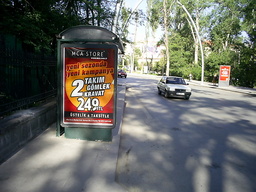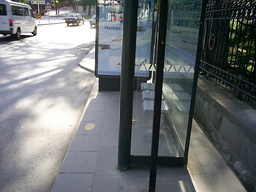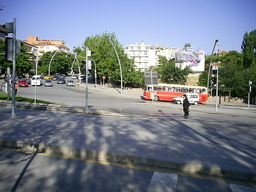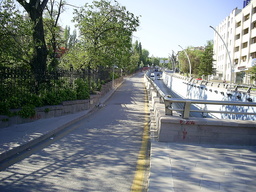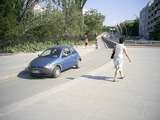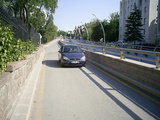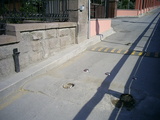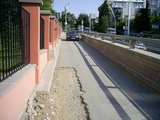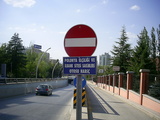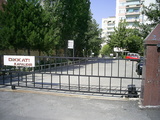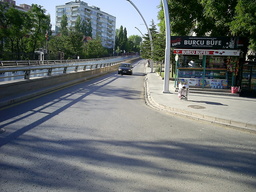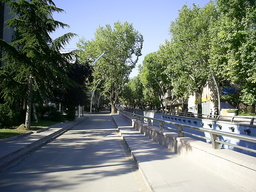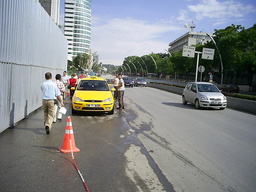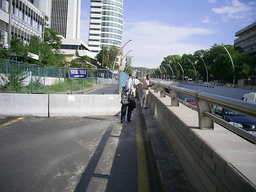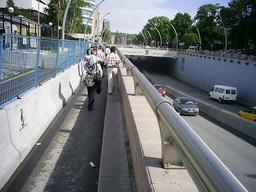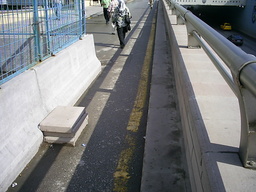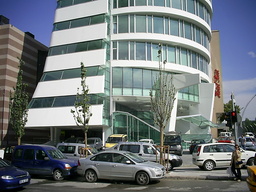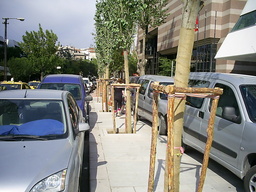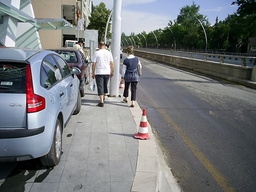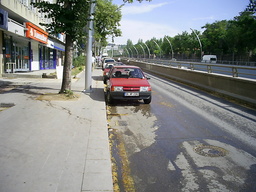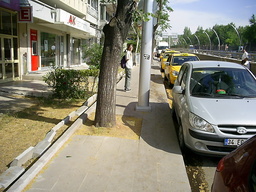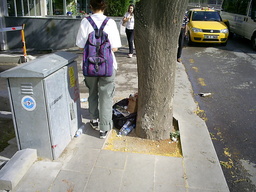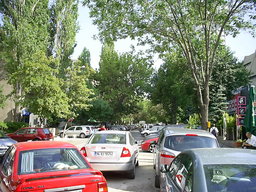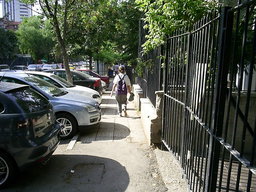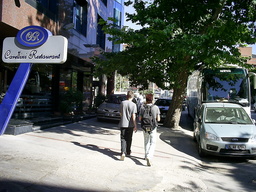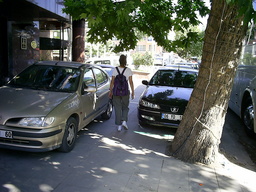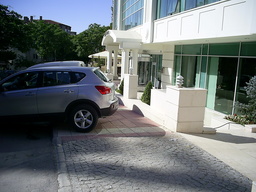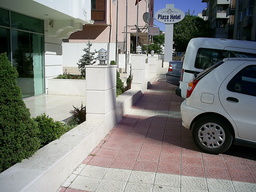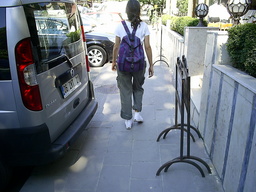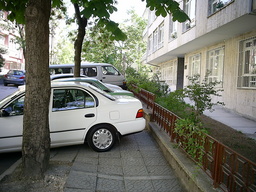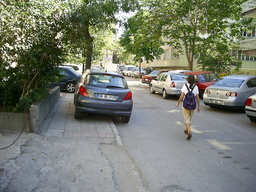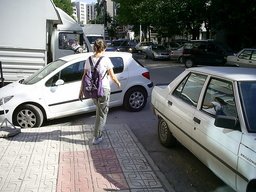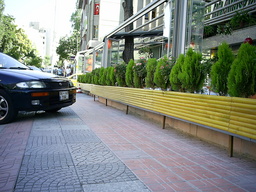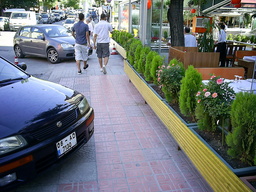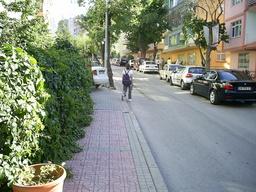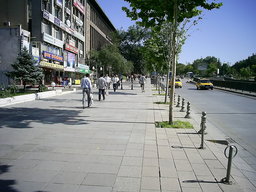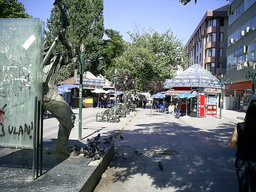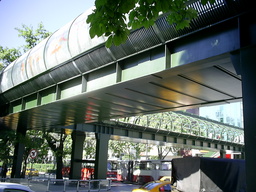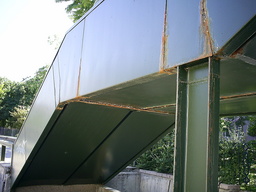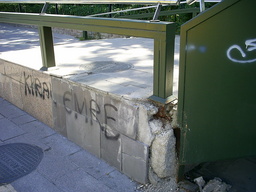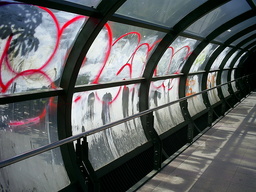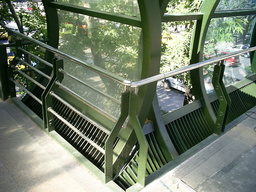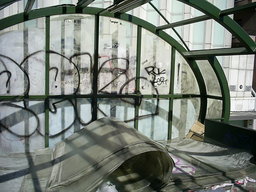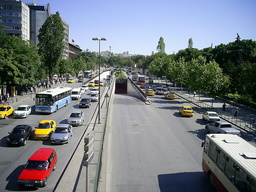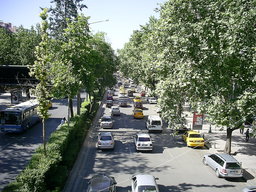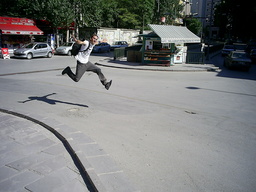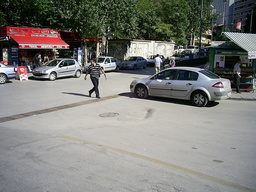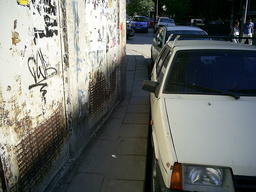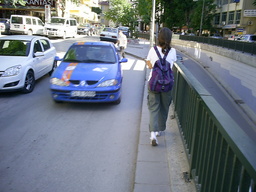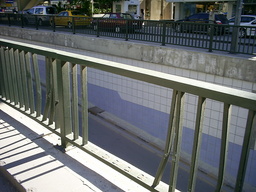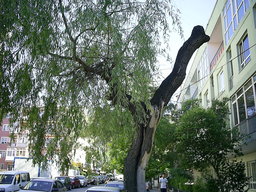Ankara
Written in 2008, this is about Ankara from the point of view of a pedestrian. Turkish terms are in a glossary at the end.
Kuğulu Kavşağı

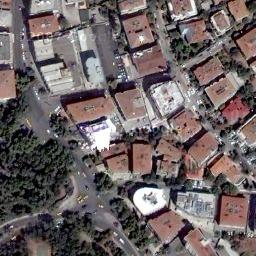
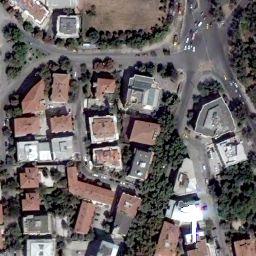
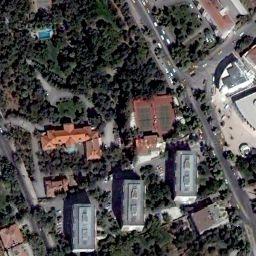
Atatürk Bulvarı and Tunalı Hilmi Caddesi are connected by Polonya Caddesi, which passes between Kuğulu Park (i.e. park with swans) and the thickly wooded grounds of the Polish Embassy. When I moved to Ankara in 2000, Polonya Caddesi had a median strip with some trees, as can be seen in the image above from Google Earth. Now that strip is gone. A bus shelter on the embassy side prevents people from actually walking past on the sidewalk: they must squeeze between two barriers, or else step onto the asphalt of the car road. What do you do if you have a baby carriage, or a wheelchair?
Polonya Caddesi, Atatürk Bulvarı, and three other roads meet where there used to be a traffic circle. Now there is—what? Various connections on the surface are controlled by lights; three of the roads are also connected under ground. For pedestrians there are some zebra crossings, again controlled by signals. But there is not an obvious logic to the intersection, as there might be if the circle remained. I do however remember that circle as jammed with cars.
Protokol Yolu
Heading south from the crossroads up to the Presidential Palace is the continuation of Atatürk Bulvarı known as Protokol Yolu. It used to be two way; now it is one way, to the north—or downhill. Only pedestrians can head south. Approaching the Kuğulu Kavşağı from the north, drivers have three choices. They can take the middle way, into the tunnel. They can take the ground-level way, on the left. Or they can take the ground-level way on the right.
In order to give drivers so many choices, pedestrians were sacrificed. Here is the way up the eastern side of the road.
There used to be a barrier to prevent the general public from driving on this road. Only embassy personnel and residents of the adjacent apartment complex were supposed to use the road. A sign at the top continues to say this.
By the way, one used to be able to use the parking lot of that apartment complex in order to walk between Protokol Yolu and Iran Caddesi (the continuation of Tunalı Hilmi Caddesi); now a guarded gate prevents this.
There is not much of a sidewalk on the western side of the road either.
Cinnah Caddesi
Cinnah Caddesi (named for the founder of Pakistan) also meets the Kuğulu Kavşağı. It used to be a two-way road with a median; car traffic was restricted to the space between ranks of great plane trees. Now the median has been erased, all car traffic is uphill, and one of the sidewalks beyond the trees has been obliterated for car access.
Atatürk Bulvarı
When I took the photos below in June, 2008, and for a long time before that, if you walked towards the Kuğulu Kavşağı from the north along Atatürk Bulvarı, on the east side of the road, then you had to walk on the road, on the same surface with speeding cars. Corrugated steel walls pushed you away from the reconstruction at Ankara Hotel, which stood empty for years (but where I attended a wedding in 1998); waiting taxis restricted your way. Soon your way was restricted by a more permanent barrier. The access road above the sunken highway was narrowed by Jersey barriers for no discernible reason. Forget about wheelchairs and baby carriages; two able-bodied people from opposite directions could hardly pass comfortably if one of them did not step up onto the narrow curb.
That was so in June. Then in July, it appeared that, in front of the hotel construction, Jersey barriers were in place to provide a safe pedestrian passage—except that the passage was blocked to pedestrians! And the road up ahead had been opened up to cars, although the sidewalk for pedestrians was not completed! (Unfortunately I lost the original large versions of these photos. In the middle, perhaps you can make out how close the bus comes to the walking woman.)
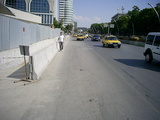
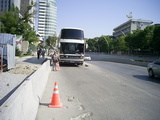
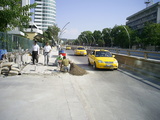
Where Kennedy Caddesi meets Atatürk Bulvarı, opposite the American Embassy, there is a building under construction with sides billowing out towards that embassy. Large new trees have been planted: may they survive in the harsh climate of Ankara. But cars are parked so that pedestrians can barely squeeze between them and the trees.
Continue walking south along the bulvar, or trying to. The sidewalk used to be quite wide here. Now that width has been taken up for a surface-level car-road while the main carriage-way has been sunken. This is the main road through Ankara, named for the founder of the republic. It is lined with embassies. And it is now a superhighway where people are not welcome.
Kaldrımlar
It is said that Turkish people visit Europe and are shocked at how many people are in wheelchairs. Turkey has just as many people who would use wheelchairs if they could; they just can’t go anywhere.
In Turkey, children are loved as much as anywhere—unless it is a question of providing their parents with a way to take them out for a stroll. Then, the options provided are few, and they are constantly being made fewer, at least in Ankara.
The southern end of Tunus Caddesi is beautifully shaded with trees. But cars there are either double-parked or perpendicularly parked. In the latter case, nothing prevents them from blocking half the sidewalk.
Hotels are especially notable for using sidewalks as parking lots.
But all over, one can see that there is simply no sense that people deserve a place to walk without fear of being run over by a car.
There are however still some sidewalks that provide plenty of space. Some streets are even closed to cars, though perhaps open to business.
Üstgeçitler
Pedestrians are expected to stay out of the way of cars on some busy roads by taking overpasses. Often these are poorly constructed and maintained. Rainwater does not drain properly from this one (built since my arrival), so it rusts. Almost all of the chrome decorative rails have been broken off and removed, presumably by scavengers who can find no other source of income. The plastic windows became opaque with age and spraypaint, though they were being replaced when we happened by one day. Before the new panels were put up, a nice view was available, if you like busy roads.
Akay Kavşağı
When two levels of car underpasses were dug at Akay Caddesi, a large car-free island was created. This was apparently too obstructive to cars, so it has been shrunk once or twice. The young man who jumped into my photo asked afterwards for a lira and pointed out a large depression in the asphalt.
Ağaçlar
Municipal workers sometimes trim trees. They don’t know what they are doing. Some trees are simply killed. This one was half-killed.
Glossary
- ağaç
- tree
- bulvarı
- boulevard
- cadde
- avenue
- kaldırım
- sidewalk
- kavşak
- crossroads
- üstgeçit
- overpass
- yol
- way
